Shark expert, Dr Tristan Guttridge and ex-marine commando & conservationist, James Glancy undertake the ultimate shark stakeout; to live, sleep and eat underwater as they investigate reports of monster great hammerhead sharks off Andros Island, Bahamas.
‘It’s a mad idea. We’re going to put a tent underwater. We’re going to live in it for 10 hours, go on these forays out to the reef, the drop off, and try and figure out what these big sharks are doing here in Andros’
RaymonTristan Guttridge

The team use brand new technology to investigate – the ‘Ocean Space Habitat’.
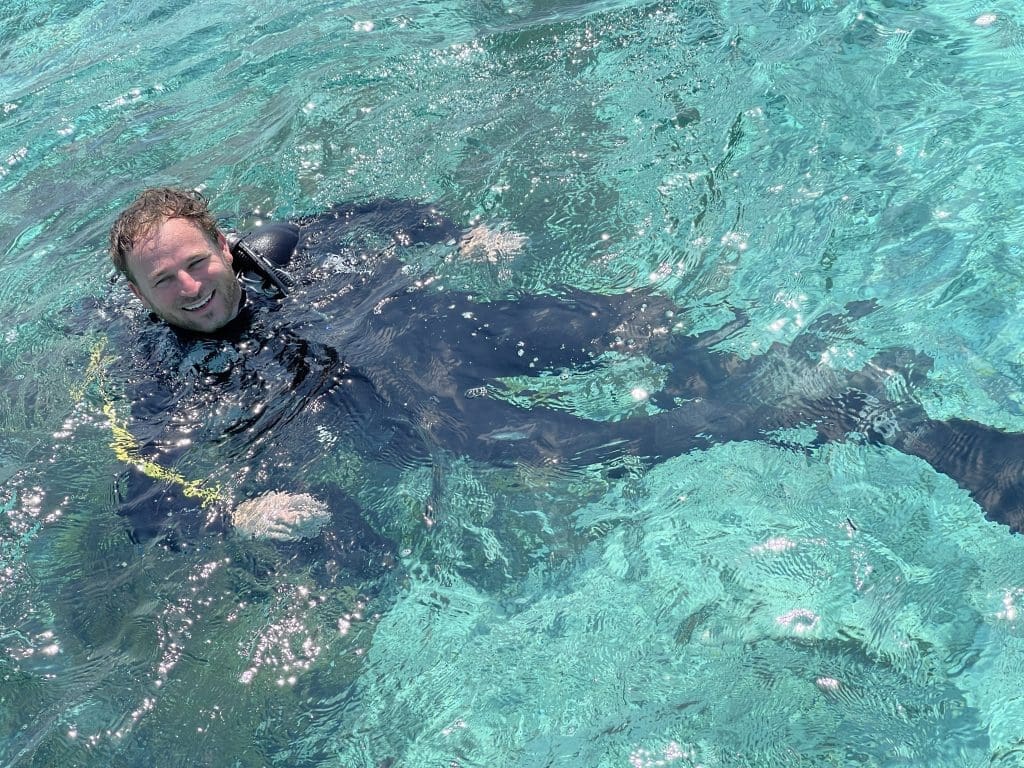
In the last two years Tristan has tracked 7 great hammerheads in the area. He suspects a sub population of the highly endangered great hammerhead could be resident in Andros. If the island is a year-round sanctuary, it could be an important breakthrough for a species in danger of extinction.
‘Normally you have to surface between each air dive and that’s massively restricting on your ability to observe sharks underwater. This tent gives us the ability to dive day and night repetitively. It’s going to break the boundaries of what we can see and observe of shark behavior’
James Glancy
The tent is the brainchild of diving technologist Mike Lombardi. A life support system keeps the air fresh in a similar way to a submarine. While inside it, Tristan and James will be able to breathe normally, even have a cup of tea, and use it to rest and decompress between dives. But deploying the prototype tent is full of risk.
‘The operation itself is the most complex that we will have attempted with this type of technology. The highest risk part is anchoring because the habitat is such a buoyant structure, it’s thirty-six hundred pounds buoyant, which is a huge amount of upward force. If the guys are in there and the anchor fails, the habitat will come exploding to the surface, that’s really dangerous. It would be very unlikely they would survive’
Mike Lombardi
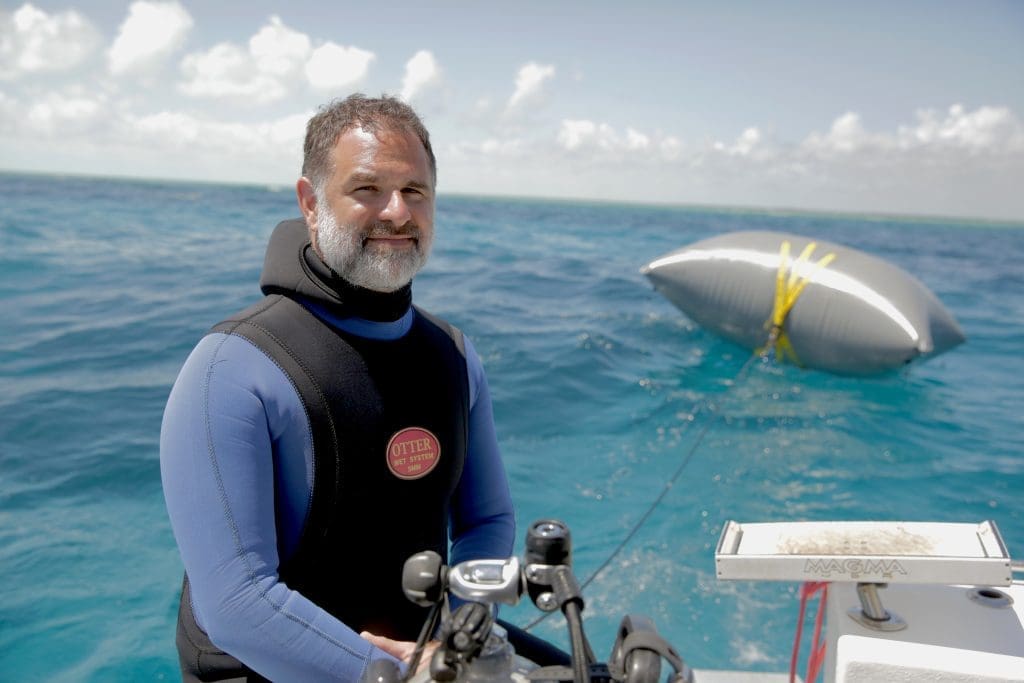
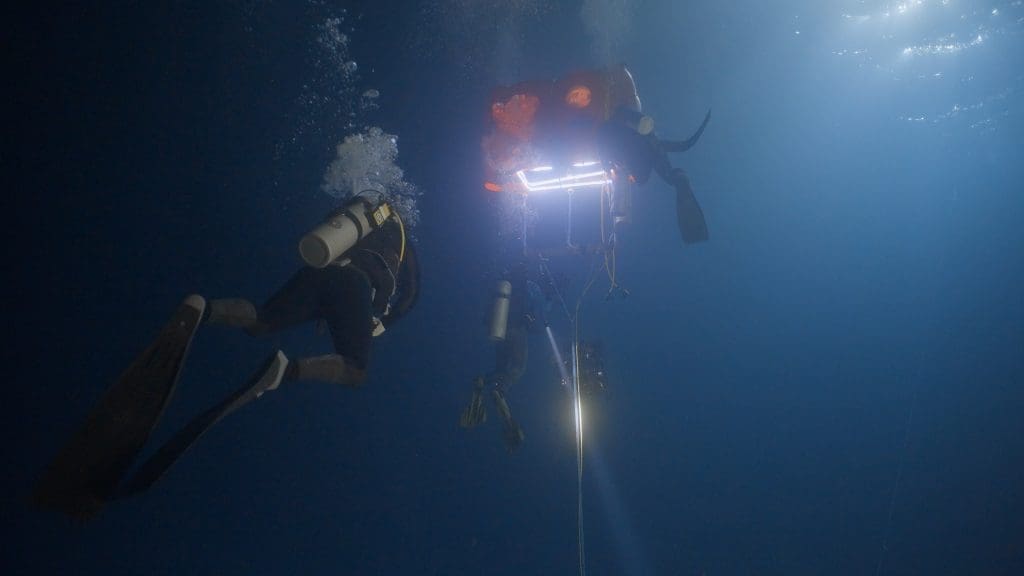
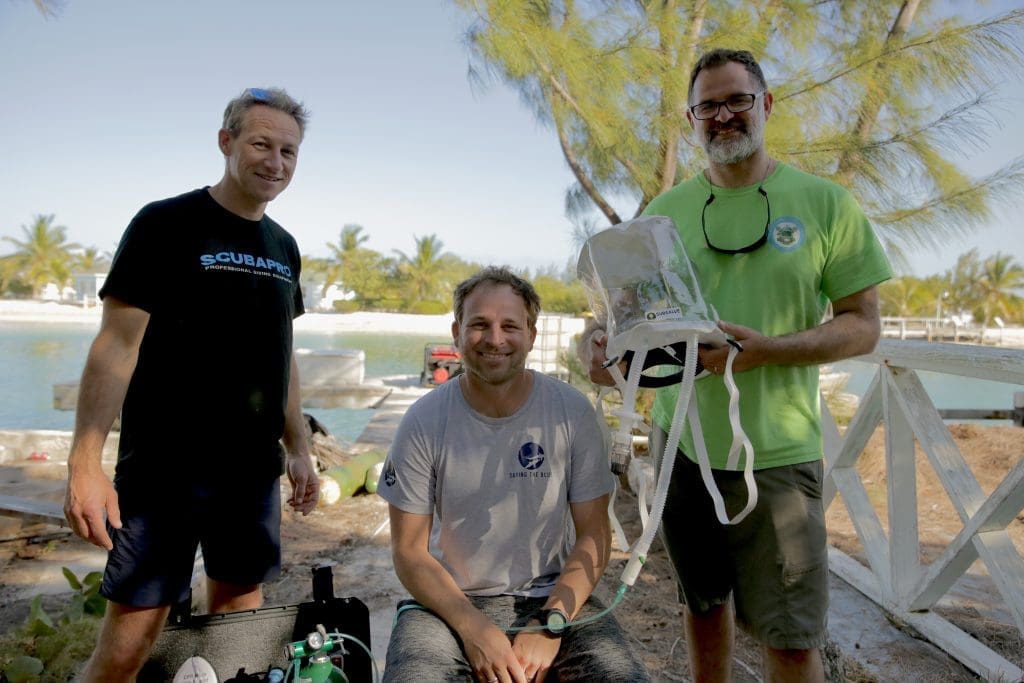
The team have to overcome numerous challenges; from finding a safe place, out of strong of current to deploy the tent, to an explosive fail of the anchoring system which puts the whole mission in jeopardy. As Tristan and James wait for the technical issues to be overcome, they scout the channel that connects the deep water drop off, to the shallow flats in the interior. Here they spot their first great hammer.
Two days later, with technical issues overcome, Mike Lombardi greenlights the mission and Tristan and James are ready to for the ultimate hammerhead stakeout. They take their last breaths of surface air at 3.30am. All going well they won’t surface again until 1.30 in the afternoon, some ten hours later!
Using the tent as their base, Tristan and James first dive the drop off at night. To help them see in the dark, James uses a secret weapon – a state of the art military sonar system which can detect any sharks within 300ft.


‘ I can see sharks through the darkness on this sonar. It’s a tiger shark! Every time you see a tiger shark you just think, right, I need to have my wits about me, I need to be alert. This is one of the top most fearsome predators’
James Glancy
After a close encounter with a tiger, James and Tristan retrieve camera traps set 2 days earlier. Back in the tent, floating at 20 feet, they review the footage. There’s more spectacular evidence the area could indeed be of vital importance as the cameras record two more great hammerheads!
Three hours and 23 minutes into the stakeout, Tristan and James head off for their second dive, back to the channel where they saw their first great hammer two days earlier. Once again, they spot a hammer, and just like their previous sighting, it heads west in the direction of the Flats in the interior.
To see a second great hammerhead in the channel, suggests Andros is indeed a new hotspot. The sightings offer fresh hope for this endangered shark, whose populations are increasingly threatened by over fishing. The big question is why are they here?
Five hours into the dive Tristan and James are back in the tent, and being Brits, they have one thing on their mind.
‘Hello topside this is habitat – can you send cups of tea down please?’

As they drink their tea something remarkable happens. A 13-foot hammer circles the tent.
‘This is what this is all about – a great hammerhead about 30ft away from the habitat… that is stunning. This is exactly why we’re here – absolutely amazing’
Glancy.
As they leave the tent for the final time, they head to the Flats, a vast tidal area fringed by mangroves and protected by barrier reef, to try and find out what’s drawing these hammers in. They’ve now been living underwater for ten hours, ten times longer than the average scuba dive. As the waters shallow, they finally discover why the hammers are here.
‘Straight away you could see how rich this area is. There’s SO much food here, it’s clear why the hammerheads are heading here. It’s such a rich hunting ground’
Guttridge.
Ten hours and 15 minutes in, the longest shark dive is over.
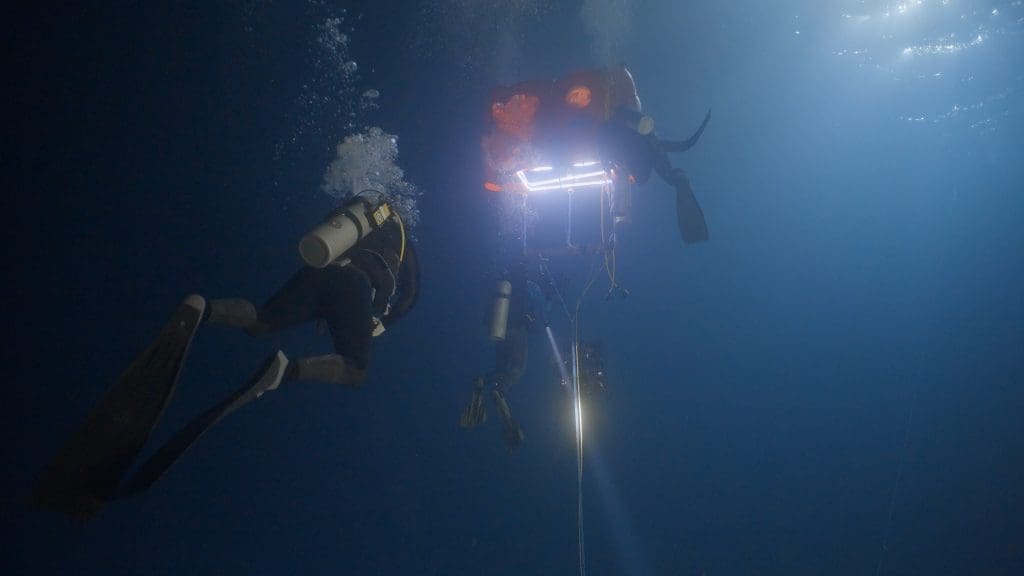
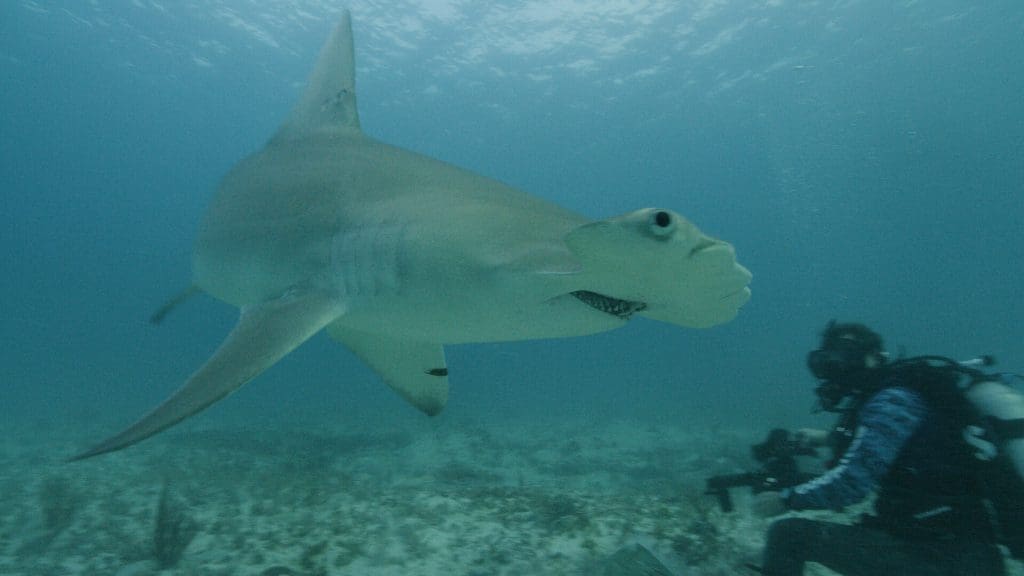
‘The most important finding from this expedition is that there seems to be more great hammerheads here in Andros. And the tent gave us that fascinating, unique insight that time in the water, that time in the system, to start to unravel some of those secrets that the hammerheads are holding. But there was one other big payoff. Seeing so many juveniles, suggests the flats could also be an important shark nursery ground and this is so awesome to see. It just showed how critical this untouched, remote island is for so many shark species.There are a lot more great hammerheads here than I first thought. Andros potentially has a huge role for this species’
Guttridge.
More Productions with sharks and stunts!
- Narrator: MOCEAN MELVIN
- Director : MIKE CUNLIFFE
- Executive Producer: SARAH CUNLIFFE
- Producer and Writer: EMMA ROSS
- Editor: RICK APLIN
- Presenter: TRISTAN GUTTRIDGE
- Presenter: JAMES GLANCY
- Director of Photography: PIERS LEIGH
- Underwater Photography: DUNCAN BRAKE
- Underwater Photography: MORNE HARDENBERG
- Underwater Photography: MARK VAN COLLER
- Sound Recordist and Drone Operator: TAMARA STUBBS
- Data Wrangler: ROSS CRAIG
- Diving Technologist: MICHAEL LOMBARDI
- Medical Consultant: BEN ABOE
- Paramedic: JENNIFER HAVENS
- Dive Safety Supervisor: NEIL BROCK
- Safety Diver: ALONZO CURRY
- Safety Diver: JAY MALY
- Safety Diver: GEPETTO ROLLE
- Safety Diver: LILI WAGNER
- Head of Production : VANESSA TUSON
- Head of Finance: KIM KEYS
- Production Manager: LINDA BELL
- Production Assistant: RHIANNON BURTON
- Production Assistant: ESME HEDLEY
- Picture Post Production: VIRTUAL POST
- Colourist: SARINA MCCAVANA
- Online Editor: FRED BAILLOD
- Sound Post Production : RED SIX
- Re-Recording Mixer: ANDREW WILSON AMPS CAS
- Sound Editor: OWEN PETERS AMPS MPSE
- Titles and Graphics: JASON KEDGLEY
- Titles and Graphics: GORILLA EDITORS
- Titles and Graphics: WILLIAM BOWER
- Titles and Graphics: BIKI GURUNG
- Titles and Graphics: MAXIM YOUNG
- 3D Artist: RALPH PINEL
- Archive Courtesy Of: AIRBUS DS
- Archive Courtesy Of: DUNCAN BRAKE
- Archive Courtesy Of: LINDSAY CARROLL
- Archive Courtesy Of: CLARK MORGAN
- Archive Courtesy Of: NASA
- Special Thanks : BAHAMAS FILM COMMISSION
- Special Thanks: BAHAMAS TOURIST OFFICE
- Special Thanks: BIMINI SCUBA
- Special Thanks: LOMBARDI UNDERSEA
- Special Thanks: NEW YORK UNIVERSITY
- Special Thanks: SAVING THE BLUE
- Special Thanks: SHARK MARINE TECHNOLOGIES INC
- Special Thanks: SUBSALVE USA
- Special Thanks: UNIVERSITY OF ARIZONA
- Special Thanks: KEITH COWLEY
- Special Thanks: MARSHALEISE LEVARITY
- Special Thanks: RAYMOND MACKEY JR
- Special Thanks: COLE MCVAY
- Special Thanks: JASON SPRINGER
- Special Thanks: CAMILLE TAYLOR
- Special Thanks: NEAL WATSON
- :
- For Discovery Channel:
- Executive Producer: CARTER FIGUEROA
- Coordinating Producer: CANDICE ALLGOOD
- Produced by BIG WAVE PRODUCTIONS for DISCOVERY CHANNEL ©2021 Discovery or its subsidiaries and affiliates:
